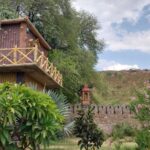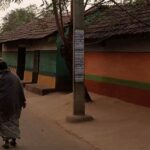The Santal women of Bubeijoda village in Bisoi block of Mayurbhanj district in Odisha are proud to uphold their age-old tradition of painting the mud walls of their houses. The Santals (or Santhals) are the largest tribal community in India, who live mainly in Bihar, Jharkhand, Odisha, Chhattisgarh and West Bengal.
Also Read | Odisha village continues to keep traditional art alive
Bubeijoda village is home to around 100 households that belong to the Santal community. Each house is unique in terms of its wall painting, shape and dimension. Most of the houses have clay tile roofs while some others are made of asbestos. The walls are made of wooden planks plastered with mud and cow dung.
Also Read | FTLO art, visit this West Bengal village
Saibati Soren (centre) is one of the oldest women in the village. She has taught teenage girls the art and process of painting murals. “It may look very beautiful. But it takes around one week of intensive work,” said Saibati.
Also Read | Saving Khovar and Sohrai arts of “painted villages”
A woman shows white clay that has been preserved for more than a year. Each year, a small portion of the clay ball is used as white colour for the wall painting.
Also Read | Bayalu Chitralaya: Karnataka village eyes reclaiming artistic past
Once a year, the women trek to nearby hills and forests to collect different types of soil carrying natural pigments in shades of red, yellow, black, etc. Red, black and white are the predominant colours used. Natural deposits like iron ore and coal, and fungi growing around the perennial streams flowing throughout the mountains are the major sources of diverse colours. White clay is collected from the river bed during summer. Red soil gets its colour from the iron oxide that’s present in large quantities here.
Also Read | Indigenous art forms of Santhal Pargana are in need of revival
The walls are generally painted in the autumn months around the Diwali festival. Each household changes the artwork every year, with women spending a considerable time to visualise and plan the new patterns and colour scheme.
The paintings depict a lot of flowers, leaves and trees. They are drawn symmetrically, with geometric patterns and floral motifs being combined to create borders that decorate the walls. Black colour is mostly used to create a band at the bottom of the wall.
“These paintings replicate their perception of life,” said Hemant Soren, a Santal activist hailing from Bisoi block of Mayurbhanj. “They reflect the ancient tradition of storytelling in India.”
Over the years, the practice has been fading in many parts of the region. Sourcing natural pigments has become a major challenge. “It’s very time-consuming,” Saibati Soren said, adding that girls are now not interested in walking to far-off places to collect colouring material. Bubeijoda village however has so far been able to continue the tradition. “The day all the houses in the village become pucca, we may lose our ancient wall art. Paintings look good on mud walls and not on cemented surfaces,” Saibati Soren said.
The lead image shows a tribal man elegantly cycling amidst the vibrant murals (Photo by Abhijit Mohanty)
Reporting and photography by Abhijit Mohanty, a Bhubaneswar-based journalist.
















